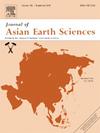碰撞后长英质岩石成因及其对大陆生长的启示:青藏高原东南部古近系二长生岩体的启示
IF 2.4
3区 地球科学
Q2 GEOSCIENCES, MULTIDISCIPLINARY
引用次数: 0
摘要
目前尚不清楚大陆与大陆碰撞后是否发生了实质性的大陆增长。印度-亚洲碰撞后的古近系岩浆活动在青藏高原东南部产生了广泛的长英质侵入体,这些侵入体为研究碰撞后大陆的生长提供了极好的机会。本文报道了青藏高原东南部思茅地块古近系微山二长岩侵入岩的岩石学和地球化学新资料。微山侵入岩中的石英二长斑岩在地球化学上与埃达克岩相似。它们具有丰富的Sr-Nd同位素组成,(87Sr/86Sr)i比值为0.7071 ~ 0.7072,ƐNd(t)值为−4.0 ~−3.5。这些特征表明,这些岩石的起源是由分离的下地壳和上覆的地幔橄榄岩的熔体相互作用产生的熔体。渭山岩体与青藏高原东南部同古长英质岩地球化学相似性表明它们具有共同的成因。详细的定量模拟表明,这些岩石的形成只涉及少量的地幔成分(不到20%),与此同时,大量的下地壳(厚度约为10 km)通过分层作用被再循环到地幔中。因此,我们认为在古近纪大陆碰撞后,TP东南部地区可能没有发生实质性的大陆生长。本文章由计算机程序翻译,如有差异,请以英文原文为准。

Petrogenesis of post-collisional felsic rocks and implications for continental growth: Insights from a Paleogene monzonitic intrusion, southeastern Tibetan Plateau
It is unclear if substantial continental growth occurs after continent–continent collision. Paleogene magmatism immediately after the India–Asia collision produced widespread felsic intrusions in the southeastern Tibetan Plateau (TP) and these intrusions provide an excellent opportunity to study continental growth in a post-collisional setting. In this paper, we report new petrological and geochemical data for a representative intrusion, the Paleogene Weishan monzonitic intrusion in the Simao Block of the southeastern Tibetan Plateau. The quartz monzonite porphyries in the Weishan intrusion are geochemically similar to adakitic rocks. They have enriched Sr–Nd isotopic compositions, with (87Sr/86Sr)i ratios of 0.7071–0.7072 and ƐNd(t) values from −4.0 to −3.5. These features are indicative of an origin of these rocks from melts that were produced by the interaction between melts derived from delaminated lower crust and overlying mantle peridotite. The geochemical similarities between the Weishan intrusion and coeval felsic rocks in the southeastern TP suggest a common origin. Detailed quantitative modeling demonstrates that only a small amount of mantle component (less than 20 %) was involved in the formation of these rocks, and at the same time, a large volume of the lower crust (with a thickness of roughly 10 km) was recycled into mantle by delamination. Therefore, we suggest that substantial continental growth might not have occurred in the southeastern TP region during the Paleogene after continent–continent collision.
求助全文
通过发布文献求助,成功后即可免费获取论文全文。
去求助
来源期刊

Journal of Asian Earth Sciences
地学-地球科学综合
CiteScore
5.90
自引率
10.00%
发文量
324
审稿时长
71 days
期刊介绍:
Journal of Asian Earth Sciences has an open access mirror journal Journal of Asian Earth Sciences: X, sharing the same aims and scope, editorial team, submission system and rigorous peer review.
The Journal of Asian Earth Sciences is an international interdisciplinary journal devoted to all aspects of research related to the solid Earth Sciences of Asia. The Journal publishes high quality, peer-reviewed scientific papers on the regional geology, tectonics, geochemistry and geophysics of Asia. It will be devoted primarily to research papers but short communications relating to new developments of broad interest, reviews and book reviews will also be included. Papers must have international appeal and should present work of more than local significance.
The scope includes deep processes of the Asian continent and its adjacent oceans; seismology and earthquakes; orogeny, magmatism, metamorphism and volcanism; growth, deformation and destruction of the Asian crust; crust-mantle interaction; evolution of life (early life, biostratigraphy, biogeography and mass-extinction); fluids, fluxes and reservoirs of mineral and energy resources; surface processes (weathering, erosion, transport and deposition of sediments) and resulting geomorphology; and the response of the Earth to global climate change as viewed within the Asian continent and surrounding oceans.
 求助内容:
求助内容: 应助结果提醒方式:
应助结果提醒方式:


